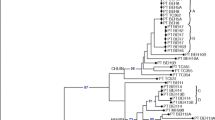Abstract
A genetic fingerprinting technique (AFLP) was used to determine the relationships among Capparis spp. Genetic distances, based on AFLP data were estimated for 45 accessions of Capparis species, from Spain, Morocco and Syria. The results of this analysis support the differentiation of four of the five taxa involved. The group of plants recognised as C. spinosa on the basis of morphological characters, includes several cultivars and appears in an intermediate position between C. orientalis and C. sicula and overlaps with C. orientalis. The other two species C. aegyptia and C. ovata are separate from the rest. Capparis spinosa had a low number of unique bands in comparison with the other species. Although these results cannot confirm the hybrid origin of C. spinosa, the distribution of the bands supports this hypothesis, the most likely parental species being C. orientalis and C. sicula.
Similar content being viewed by others
References
A. Alvarruiz M. Rodrigo J. Miguel V. Giner A. Feria R. Vila (1990) ArticleTitleInfluence of brining and packing conditions on product quality of capers J. Food Sci. 55 196–198
G. Barbera R.D. Lorenzo (1984) ArticleTitleThe caper culture in Italy Acta Hort. 144 167–171
A. Caccette (1985) ArticleTitleAspetti economici della coltivazione del cappero in Italia Rivista di Frutticoltura 12 21–28
P. Casgrain X. Legendre (1999) The R Package for Multivariate and Spatial Analysis Version 4.0 (development release 4) Département de Sciences Biologiques, Universiteal Quede Montrébec Canada
M.W. Chase H.G. Hills (1991) ArticleTitleSilica gel: an ideal material for field preservation of leaf samples for DNA studies Taxon 40 215–220
J.J. Doyle J.L. Doyle (1987) ArticleTitleA rapid DNA isolation procedure for small quantities of fresh leaf tissue Bull. Bot. Soc. Am. 19 11–15
S. Fici L. Gianguzzi (1997) ArticleTitleDiversity and conservation in wild and cultivated Capparis in Sicily Bocconea 7 437–443
S. Fici (2001) ArticleTitleIntraespecific variation and evolutionary trends in Capparis spinosa L. (Capparaceae) Plant Syst. Evol. 228 123–141
Greuter W. and Burdet J. (1984) Med-Checklist, vol. 1, Conservatoire et Jardin botaniques de la Ville de Genéve (ed.), Genova, 330 pp.
K. Hammer (2001) ArticleTitleCapparaceae In: Hanelt P. and Institute of Plant Genetics and Crop Plant Research (eds), Mansfeld’s Encyclopedia of Agricultural and Horticultural Crops, vol. 3 1406–1412
Higton R.N. and Akeroyd J.R. (1991) Variation in Capparis spinosa L in Europe. Bot. J. Linn. Soc. 104‐113
M.A. Innis (1990) PCR Protocols: A Guide to Methods and Applications Academic Press New York 500
C. Inocencio D. Rivera F. Alcaraz F.A. Tomás-Barberán (2000) ArticleTitleFlavonoid content of commercial capers (Capparis spinosa, C. sicula and C. orientalis) produced in Mediterranean countries Eur. Food Res. Technol. 212 IssueID1 70–74
C. Inocencio (2001) ArticleTitleCaracterizació nde Capparis L Subgénero Capparis (Capparaceae). Universidad de Murcia, (PhD Thesis), 306 306
P. Jaccard (1908) ArticleTitleNouvelles recherches sur la distribution florale Bull. Soc. Vaud. Sci. Nat. 44 223–270
S. Khouildi M.A. Pagnotta O.A. Tanzarella A. Ghorbel E. Porceddu (2000) ArticleTitleSuitability of RAPD (random amplified polymorphic DNA) technique for estimating the genetic variation in natural genotypes of Tunisian and Italian caper(Capparis spinosa L.). Agricoltura-Mediterranea 130 IssueID1 72–77
K. Mullis (1986) ArticleTitleSpecific amplification of DNA in vitro: the polymerase chain reaction Cold Spring Harbor Symp. Quant. Biol. 51 260
R.D.M. Page (1996) ArticleTitleTREEVIEW: an application to display phylogenetic trees on personal computers Comput. Appl. Biosci. 12 357–358
D. Rivera F. Alcaraz C. Inocencio C. Obón E. Carreño (1999.) Taxonomic study of cultivated Capparis Sect. Capparis in the Western Mediterranean. S. Andrews A.C. Leslie C. Alexander (Eds) Taxonomy of Cultivated Plants Royal Botanic Gardens of Kew London 451–455
D. Swofford (2002) PAUP Phylogenetic Analysis Using Parsimony. Version 4. Sinauer Associates Sunderland, Massachusetts
P. Vos R. Hogers M. Bleeker M. Reijans T. Lee Particlevan de M. Hornes A. Frijters J. Pot J. Peleman M. Kuiper M. Zabeau (1995) ArticleTitleAFLP: new technique for DNA fingerprinting Nucleic Acids Res. 23 4407–4414
M. Zohary (1960) ArticleTitleThe species of Capparis in the Mediterranean and the near eastern countries Bull. Res. Counc. Israel 8 49–63
Author information
Authors and Affiliations
Corresponding author
Rights and permissions
About this article
Cite this article
Inocencio, C., Cowan, R.S., Alcaraz, F. et al. AFLP fingerprinting in Capparis subgenus Capparis related to the commercial sources of capers. Genet Resour Crop Evol 52, 137–144 (2005). https://doi.org/10.1007/s10722-003-4432-2
Received:
Accepted:
Issue Date:
DOI: https://doi.org/10.1007/s10722-003-4432-2




